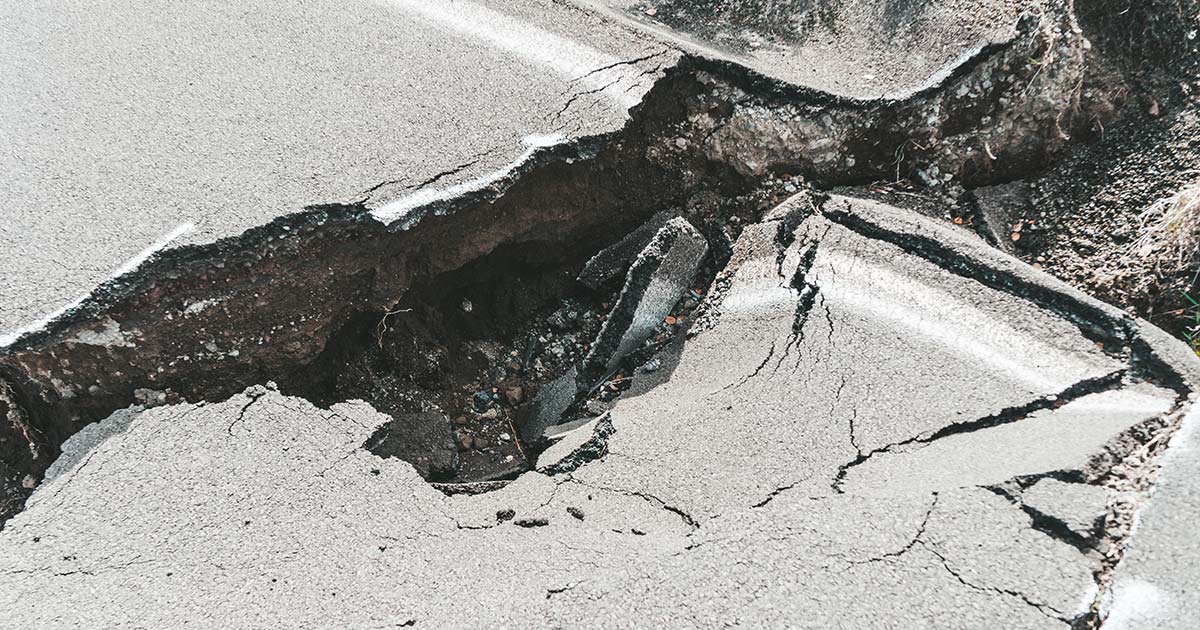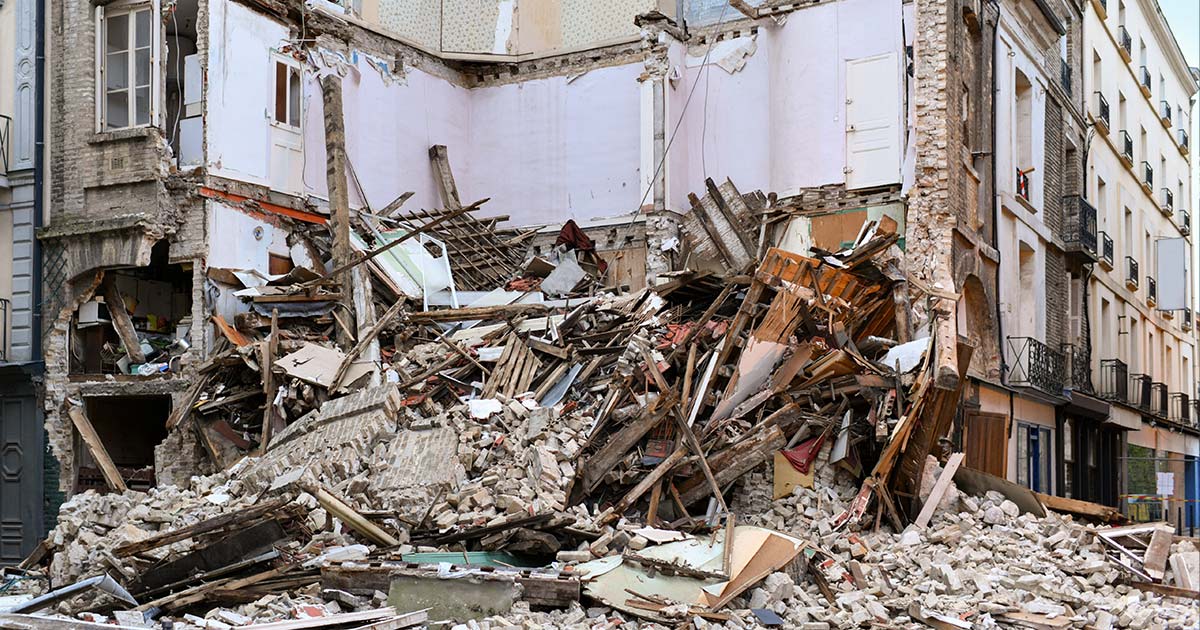As a prepper, we understand the importance of being ready for disasters that can strike without warning; earthquakes are one of those disasters that comes with little to no warning. Earthquakes can strike suddenly and cause widespread destruction, leaving communities vulnerable to the initial disaster and various challenges in the aftermath.
In this comprehensive earthquake survival guide, we will cover how to prepare for and survive an earthquake and how to deal with the potential aftermath threats, including power outages, chemical spills, local ecological disasters, looters, criminals, civil unrest, and the long-term loss of local infrastructure.

Earthquakes are no joke! They can cause widespread devastation, leaving behind a trail of destruction impacting communities, infrastructure, and lives. According to the U.S. Geological Survey (USGS), an estimated 500,000 earthquakes occur worldwide each year, with approximately 100,000 of them strong enough to be felt by humans.
Let’s take a look at some real examples of the damaging impact of earthquakes and what happened in their aftermath.
The Great East Japan Earthquake and Tsunami (2011)
One of the most devastating earthquakes in recent history was the Great East Japan Earthquake, also known as the Tohoku earthquake, which struck on March 11, 2011. With a magnitude of 9.0, it was the largest earthquake ever recorded in Japan and the fourth largest in the world. The earthquake triggered massive tsunami waves that reached 131 feet and traveled up to 6 miles inland, causing unprecedented destruction along the northeastern coast of Japan.
The impact of the earthquake and tsunami was catastrophic, resulting in the loss of more than 15,000 lives, extensive damage to infrastructure, including buildings, roads, railways, and ports, and a nuclear meltdown at the Fukushima Daiichi Nuclear Power Plant. The economic losses from this disaster were estimated to be over $200 billion, making it one of the costliest natural disasters in history.
The Haiti Earthquake (2010)
In January 2010, a 7.0 magnitude earthquake struck the impoverished nation of Haiti, causing widespread destruction and loss of life. The earthquake resulted in the deaths of over 230,000 people and injured more than 300,000. The capital city, Port-au-Prince, was particularly hard hit, with many buildings and infrastructure collapsing, including government buildings, hospitals, schools, and homes.
The aftermath of the Haiti earthquake was dire, with thousands of people left homeless, lacking access to clean water, food, and medical care. The recovery and reconstruction efforts were hampered by the already fragile state of the country’s infrastructure and social systems, resulting in long-term challenges for the affected communities.
The Christchurch Earthquake (2011)
In February 2011, a 6.3 magnitude earthquake struck the city of Christchurch in New Zealand, causing significant damage and loss of life. The earthquake resulted in the deaths of 185 people and caused extensive damage to buildings, roads, bridges, and other infrastructure.
The impact of the Christchurch earthquake was far-reaching, with widespread disruption to daily life, including the closure of businesses, schools, and public services. The recovery and reconstruction efforts were complex and lengthy, with many buildings needing to be demolished and rebuilt, and the city undergoing significant changes in its urban planning and infrastructure development.
The Nepal Earthquake (2015)
In April 2015, a 7.8 magnitude earthquake struck Nepal, causing massive destruction and loss of life. The earthquake resulted in the deaths of over 8,000 people and injured more than 21,000. Many historic and cultural landmarks, including temples, palaces, and monuments, were severely damaged or destroyed.
The aftermath of the Nepal earthquake was devastating, with widespread displacement of people, lack of access to basic necessities such as food, water, and shelter, and challenges in providing medical care and assistance to affected communities. The recovery and reconstruction efforts in Nepal continue to this day, highlighting the long-term impacts of earthquakes.

The safety of yourself and your loved ones is the most important consideration during an emergency. Having an emergency preparedness plan in place ensures that everyone in your household knows what to do, where to go, and how to communicate in case of an emergency.
“Earthquakes are inevitable, but their impact can be mitigated through preparedness. Take the time to create an earthquake readiness plan and be ready for the unexpected.”
– Dr. Richard Allen, Director of the Berkeley Seismological Laboratory at the University of California, Berkeley.
Having a well-thought-out earthquake preparedness plan in place is crucial to increase your chances of survival. Here are some essential steps to take in your earthquake preparedness plan:
Conduct a home hazard assessment: It’s important that you identify all potential hazards in and around your home that could cause injuries or property damage during an earthquake. Walk through each room and check for potential hazards that could fall, cause injury, or break during an earthquake.
- Identify potential hazards in and around your home, such as heavy furniture or appliances that could topple over during an earthquake, and take steps to secure them now. For example, install latches on cabinets to prevent contents from falling out and add wall anchors to top heavy furniture, bookcases and anything that can fall when a quake hits.
- Appliances: Look for appliances, such as refrigerators, water heaters, and washing machines, that could shift or tip during an earthquake. Make sure they are secured or braced to prevent movement.
- Light Fixtures: Check all light fixtures, such as chandeliers and ceiling fans, to ensure they are properly secured to the ceiling. Consider using seismic bracing or flexible connectors to reinforce these fixtures.
- Foundation: Check the foundation of your home for cracks, settling, or other signs of damage. Ensure that your foundation is properly reinforced and can withstand the shaking caused by an earthquake.
- Utilities: Assess the location and condition of your gas, water, and electrical lines. Make sure they are properly installed and secured to prevent leaks, breaks, or fires during an earthquake. Also make a mental note of where they are, in case you need to turn them off after the earthquake hits.
Create an emergency kit: Put together an emergency kit that includes essential supplies such as food, water, a first aid kit, a flashlight, extra batteries, tools and any medications you will need during an extended disaster. Make sure to store your emergency kit in a readily accessible location.
- Create a Bugout Bag: Depending on the size of the earthquake, the damage to local infrastructure, and threats during the aftermath, you may need to evacuate your area to stay safe. Therefore, having a Bugout bag and a Bugout plan is crucial!
- Stock up on supplies: Earthquakes can disrupt essential services such as electricity, water, and food supply. Ensure you have enough supplies to sustain yourself and your family for an extended period, including non-perishable food, clean water, and necessary medications.
- Cash and Important Documents: Keep some cash in small denominations and copies of important documents such as identification cards, insurance policies, and important contact information in a waterproof and portable container.
Create an power outage emergency kit:
Now that you have an emergency kit ready to go, it’s important to have a kit that you can easily access in case of an outage. The kit should include necessities such as flashlights, candles, batteries, a first-aid kit, a radio, a cellphone battery charger, and extra clothing or blankets. Remember to pack enough supplies for everyone in your home and ensure the kit is stored safely.
Have a backup power source:
Invest in a backup power source like a portable generator or solar panels. If you are investing in solar panels, then make sure they have enough capacity to power your essentials, such as your refrigerator or medical equipment.
Stock up on non-perishable foods:
During an outage, your fridge and freezer won’t be able to keep food cold, so be sure to stock up on non-perishable foods. Canned foods, granola bars, and crackers are all excellent options. It’s also important to keep a supply of safe drinking water on hand.
Develop a communication plan: Establish a communication plan with your family and loved ones, including designated meeting points in case you are separated during an earthquake. Also, designate an out-of-town emergency contact who can serve as a central point of contact for information during the disaster.

Earthquakes can be beyond jarring and induce quite a bit of panic. So when an earthquake strikes, it’s crucial to know what actions to take to protect yourself and increase your chances of survival. Here are some important steps to take when things start moving!
- Drop, Cover, and Hold On: This is the most recommended action to take during an earthquake. Drop to the ground to prevent being knocked over, take cover under sturdy furniture if available to protect yourself from falling debris, and hold on until the shaking stops.
- Stay away from windows and other hazards: Stay clear of windows, shelves, and other potential hazards during the earthquake. If you’re already in a safe spot, stay there until the shaking stops.
- Protect your head: Cover your head with your arms to protect yourself from falling debris or objects. If possible, grab a pillow or cushion to further protect your head from injury.
- Stay calm: It’s natural to feel scared during an earthquake, but it’s important to stay as calm as possible. Panicking can impair your ability to make rational decisions and take appropriate actions. Take slow, deep breaths and focus on protecting yourself and following your preparedness plan.

Once the shaking stops, the danger may not be over. According to a report by the National Earthquake Hazards Reduction Program (NEHRP), the economic losses from earthquakes in the United States alone can exceed $5 billion per year, with long-term recovery efforts taking months to years.
It’s important to take precautions after an earthquake to protect yourself and those around you. Here are some post-earthquake safety measures to follow:
- Check for injuries: Check yourself and others for injuries and provide first aid if necessary. Call emergency services for medical assistance if needed.
- Check for hazards: Assess your surroundings for potential hazards, such as gas leaks, damaged electrical wires, or structural damage. If you suspect any hazards, evacuate the area immediately and call the appropriate authorities for assistance.
- Turn off utilities if necessary: If you smell gas or suspect a gas leak, turn off the gas at the main valve. Also, shut off the electricity and waterlines if you suspect any damage to the electrical or plumbing systems.
- Beware of aftershocks: Earthquakes can be followed by aftershocks, which are smaller earthquakes that can still cause damage. In some cases, the first quake could also be known as a foreshock, meaning the big one may still be coming. So be prepared for aftershocks and take appropriate actions, such as moving to an open space away from buildings or objects that could potentially fall.
- Be cautious with debris: Be cautious when moving around, as there may be debris or fallen objects that can cause injury. Wear a good pair of boots and use caution when navigating through the affected area.
- Stay informed: Listen to local authorities for updates and instructions on safety measures, evacuation orders, and relief efforts. Keep an eye on what official sources are saying, but if you have access to ham radio, this will be your best option for obtaining on-the-ground information from experts who haven’t gone through the government/media filters.
“The aftermath of an earthquake can be just as challenging as the initial event. It’s important to be prepared for potential aftershocks and the potential impact on infrastructure and essential services.”
Dr. Patricia Martínez-Garzón, Geophysicist and Seismologist

The aftermath of a major earthquake can be challenging, and it’s important to be prepared for the long-term effects, such as loss of power, water, and infrastructure. But beyond these expected aftermath threats, there are a host of issues that most people never consider.
As someone who has witnessed the aftermath of major earthquakes, I can attest that one of the biggest challenges is the risk of looting and criminal activities. Let’s face it, as we cover almost daily on this website, even during the good times we have a certain segment of our population that creates chaos on a daily basis. Throw in a natural disaster and all hell can and will break loose.
During the 2010 earthquake in Haiti, looting and civil unrest erupted, with reports of mobs looting stores, homes, and aid trucks. Desperation, lack of access to basic necessities, and breakdown of law and order contributed to the dangerous situation, further complicating the relief efforts and prolonging the recovery process.
It’s imperative to take proactive measures to secure your property and remain vigilant for potential threats during such times of chaos and vulnerability.
Here are some key considerations for long-term, post-disaster survival:
- Secure your property: In the aftermath of an earthquake, looters and criminals may take advantage of the chaos. Secure your property by boarding up broken windows, reinforcing doors, and taking steps to deter potential thieves.
- Stay connected: In the aftermath of an earthquake, communication networks may be disrupted. Have alternative means of communication, such as a battery-powered radio, shortwave and ham radios, or local neighborhood networks, to stay connected with others and call for help if needed.
- Be aware of health hazards: Earthquakes can cause damage to infrastructure, leading to health hazards such as contaminated water, lack of sanitation, and exposure to hazardous materials. Take precautions, such as boiling water before consuming, practicing proper hygiene, and avoiding areas with potential health risks.
- Seek assistance if needed: If you or your family members require medical attention or emotional support, do not hesitate to seek assistance from emergency services or local support organizations. Mental health and emotional well-being are equally important in a survival situation.
Surviving a major earthquake requires preparedness, quick thinking, and proactive actions. By taking steps to prepare before an earthquake occurs, knowing how to respond during and after the event, and being prepared for the very real possibility of aftermath threats, you can increase your chances of survival. Remember to create an earthquake preparedness plan, stock up on essential supplies, secure your property, stay informed, and seek assistance if needed. Learning from past earthquakes and following our advice can help you navigate through the challenges and increase your chances of surviving a major earthquake.


